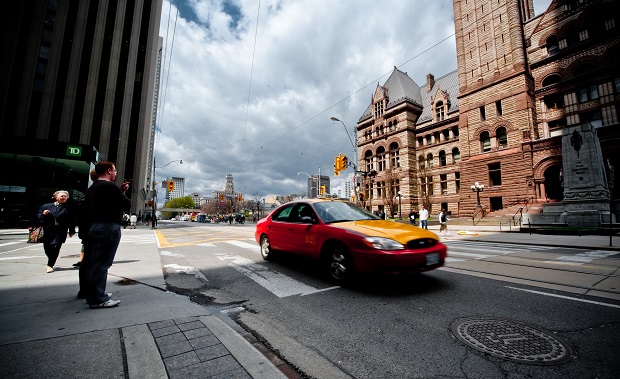In dealing with the impact on the sharing economy on transportation, Toronto officials want traditional cabbies and limousine drivers to share the city streets with Uber drivers under one bylaw but operate under different sets of rules.
The last 18 months have been tumultuous for taxi drivers and operators as they saw their monopoly encroached upon by the mobile app-powered, ride-hailing service, Uber. As cab drivers staged street protests, Uber Canada launched a PR campaign calling for commuters to urge lawmakers to come up with regulations that would legalize Uber.
On July 7, 2015, city council directed Municipal Licensing & Standards staff “to review the operations of Uber and technologies like it, including the interests of the public in the technologies and their impacts on the current taxicab industry.” In September 2015, city council directed staff to report on a framework to equitably regulate all ground transportation providers, including taxis, limos and private vehicle-for-hire services, such as Uber provides, “to level the playing field while considering the city’s accessibility objectives for the industry.”
Toronto proposes different rules for #Uber, taxis https://t.co/oEZbulVe1P via @jeffreybgray pic.twitter.com/V8SYdaGnK9
— The Globe and Mail (@globeandmail) April 7, 2016
Toronto’s taxi industry will see fewer regulations, its competitor Uber will see more https://t.co/AOQgSXouQn pic.twitter.com/GREeGNqAof
— 680 NEWS Toronto (@680NEWS) April 7, 2016
RELATED CONTENT
Uber gets go signal to operate in Edmonton
Today, Terry Cook, executive director of Municipal Licensing and Standards; and Vanessa Fletcher, policy, and planning advisor released a summary of the regulations that will be considered by Toronto’s Licensing and Standards Committee at its meeting on April 14.
“Today, we have new regulations that create a level playing field, provide safe, convenient options to our residents and allow drivers to earn a competitive leaving,” Toronto City Mayor John Tory said in a statement today.
However, at least, one councillor was not happy about the proposed changes.
“Instead of levelling the playing field, we’ve dropped the floor and completely caved to Uber, and I’m shocked by t, frankly,” Coun. Janet Davis said during a press conference.
On social media she tweeted:
Complete capitulation to Uber and standard plate owners in new taxi regulations. Consumers and drivers abandoned by de-regulation.
— Janet Davis (@Janet_Davis) April 7, 2016
The aim of the proposal is to ensure:
- Service providers all regulated under same Bylaw
- Reduce regulations for taxicabs and limousines
- Permit Private Transportation Companies (services like Uber and Lyft) to operate in the city with regulations
Réglementation spéciale pour #Uber = sécurité compromise, selon la compagnie de taxi Beck https://t.co/hSk1Eo0GB8 pic.twitter.com/8MKOVmuf4X
— Radio-Canada Ontario (@iciontario) April 7, 2016
Here’s a breakdown of some of the proposed rules
Driver screening
Taxi
- City sets screening criteria
- Criminal background and driver record checks
- Received and approved by the city
Limo
- City sets screening criteria
- Criminal Background and Driver Record checks
- Received and approved by the city
Uber
- City sets screening criteria
- Criminal background and driver record checks
- Received and approved by the Private transport companies
- Audited by the city
Fare
Taxi
- City regulated rates charged on street hail and at cab stands
- Permitted to discount from city-regulated rates when trip is booked through broker
- City rate unchanged – acts as maximum rate
Limo
- Permitted to set and charge own rates
- Remove minimum $70 per hour fare requirement
Uber
- Permitted to set and charge own rates
Licensing fees
Taxi
- Annual driver fee – $290
- Licensing fees reduced by 17% for drivers
- Training cost eliminated
Limo
- Annual driver fee – $290
- Training cost eliminated
Uber
- One-Time Application Fee: $20,000
- Annual licence and renewal calculated by $10 per driver and 20 cents per trip originating in Toronto
Driver training
Taxi
- No city-mandated training
- Free accessible training for owners and drivers of accessible taxicabs required
Limo and Uber
- No city-mandated training
Vehicle standards and insurance
Taxi
- No more than 7 model years with 4 doors
- Twice annual inspection by City
- No longer require snow tires
- $2 million liability coverage
Limo
- No more than 7 model years with 4 doors (other than stretch)
- Submit Annual safety standards certificate
- $2 million liability coverage
Uber
- No more than 7 model years with 4 doors
- Submit Annual safety standards certificate
- $2 million liability coverage
For more details on proposed regulations, click here.

